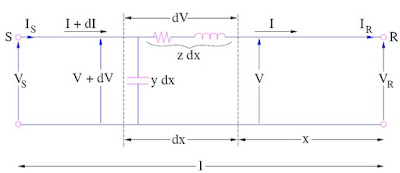Characteristic Impedance of Transmission Line
Characteristic Impedance of a Transmission line is defined as the square root of ratio of series impedance per unit length per phase and shunt admittance per unit length per phase. If z and y are series impedance and shunt admittance of line, the characteristic impedance Zc is given as
Zc = v(z/y)
Where z = R + j?L = series impedance per unit length per phase
y = G + j?C = shunt admittance per unit length per phase
Let us have a detailed discussion on the characteristic impedance and some of the important parameters associated with transmission line. For analysis purpose we consider a long transmission line. We know that a long transmission line have distributed Resistance (R) and Inductance (L) in series & Conductance (G) and Capacitance in shunt.
Shunt Conductance (G) of line basically accounts for loss occurring due to leakage current along insulator string and corona. In power line this effect is usually very small and can be neglected. |
Therefore to model a long transmission line, associated parameters needs to be distributed over the entire length as shown in figure below. Let the length of line is �l�. Let us consider a small section of line dx at a distance x from the receiving end.
Series Impedance of section dx = (series impedance per unit length)dx
= zdx
Therefore,
Voltage drop in section dx = dv = (zdx)I
dV/dx = zI �����������..(1)
Now,
Differential Current dI flowing in the shunt admittance can be found by multiplying Shunt admittance and Voltage V across the shunt admittance. Hence,
dI = (ydx)V
dI/dx = yV ����������.(2)
Differentiating equation (1) and (2) w.r.t x we get,
d2V/dx2 = z(dI/dx) =yzV ��.[ from equation (2)]
and d2I/dx2 = y(dV/dx)
= yzI ���[from equation (1)]
To get the profile of voltage and current along the line, we need to solve the above two differential equations of second order assuming receiving end voltage Vr and current Ir to be know. Also at receiving end x = 0 since differential section dx is considered at at distance of x from receiving end. The general solution of the differential equation is given below.
V = [(Vr +ZcIr)/2]e�x + [(Vr-ZcIr)/2]e-�x
I = [(Vr/Zc) + Ir]e�x + [(Vr /Zc) + Ir]e-�x
Where Zc = v(z/y) and � = vyz
The constant Zc is called Characteristic Impedance and � is called Propagation Constant. Characteristics Impedance and Propagation Constant are complex number.
Incident Voltage and Reflected Voltage
Carefully observe the voltage profile obtained along the transmission line. It is composed of two parts, [(Vr+ZcIr)/2]e�x and [(Vr-ZcIr)/2]e-�x. Let us draw a plot of the two components as shown in figure below.
Above plot of [(Vr+ZcIr)/2]e�x clearly shows that the magnitude of voltage is increasing with increase in x. This means that voltage from receiving end to sending end is increasing. This part of voltage is known as Incident Voltage.
Above plot of [(Vr+ZcIr)/2]e�x clearly shows that the magnitude of voltage is increasing with increase in x. This means that voltage from receiving end to sending end is increasing. This part of voltage is known as Incident Voltage.
Above plot of [(Vr-ZcIr)/2]e-�x reveals that the magnitude of voltage is continuously reducing with increase in x. This part of voltage is known as Reflected Voltage.
Voltage at any Point = Incident Voltage + Reflected Voltage
Thus we can say that, in a transmission line voltage at any point is the sum of incident and reflected voltage. Same process of thinking applies for current and I assume that you can get the idea about current by yourself.
Flat or Infinite Transmission Line
A flat transmission line is defined as a line terminated with characteristic impedance. Such line is also called Infinite Transmission Line. Since line is terminated with characteristics impedance, hence Vr = ZcIr
Thus Incident Voltage at any point x on line = [(ZcIr +ZcIr)/2]e�x
= ZcIre�x
Let � = yz = a+jb where a and b are constant.
Hence, Incident Voltage at any point x on line = ZcIre(a+jb)x
= ZcIreaxejbx
Magnitude of incident voltage = ZcIreax since magnitude of ejbx is 1.
Reflected Voltage at any point on Line = [(Vr-ZcIr)/2]e-�x
= [(ZcIr - ZcIr)/2]e-�x
= 0
Thus a flat or infinite line is having no reflected voltage but only incident voltage. This can also be though in another but ridiculous way. If line is of infinite length then how can it have reflected voltage? Where from will it get reflected? So no reflected voltage in infinite or flat line.
Characteristic Impedance of Transmission Line
 Reviewed by haru
on
October 18, 2017
Rating:
Reviewed by haru
on
October 18, 2017
Rating:
 Reviewed by haru
on
October 18, 2017
Rating:
Reviewed by haru
on
October 18, 2017
Rating:











No comments